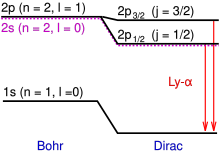
Back انزياح لامب Arabic Лэмбаўскі зрух Byelorussian ল্যাম্ব অপসরণ Bengali/Bangla Desplaçament de Lamb Catalan Lamb-Verschiebung German Efecto Lamb Spanish جابهجایی لمب Persian Lambin siirtymä Finnish Décalage de Lamb French הסחת לם HE
| Quantum field theory |
|---|
 |
| History |

In physics the Lamb shift, named after Willis Lamb, refers to an anomalous difference in energy between two electron orbitals in a hydrogen atom. The difference was not predicted by theory and it cannot be derived from the Dirac equation, which predicts identical energies. Hence the Lamb shift refers to a deviation from theory seen in the differing energies contained by the 2S1/2 and 2P1/2 orbitals of the hydrogen atom.
The Lamb shift is caused by interactions between the virtual photons created through vacuum energy fluctuations and the electron as it moves around the hydrogen nucleus in each of these two orbitals. The Lamb shift has since played a significant role through vacuum energy fluctuations in theoretical prediction of Hawking radiation from black holes.
This effect was first measured in 1947 in the Lamb–Retherford experiment on the hydrogen microwave spectrum[1] and this measurement provided the stimulus for renormalization theory to handle the divergences. It was the harbinger of modern quantum electrodynamics developed by Julian Schwinger, Richard Feynman, Ernst Stueckelberg, Sin-Itiro Tomonaga and Freeman Dyson. Lamb won the Nobel Prize in Physics in 1955 for his discoveries related to the Lamb shift.
- ^ G Aruldhas (2009). "§15.15 Lamb Shift". Quantum Mechanics (2nd ed.). Prentice-Hall of India Pvt. Ltd. p. 404. ISBN 978-81-203-3635-3.
© MMXXIII Rich X Search. We shall prevail. All rights reserved. Rich X Search